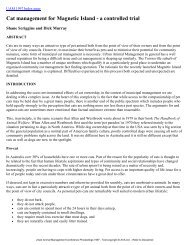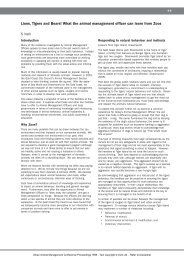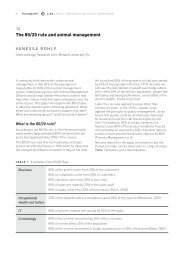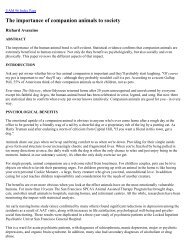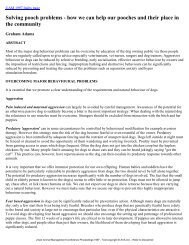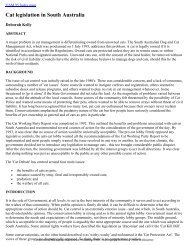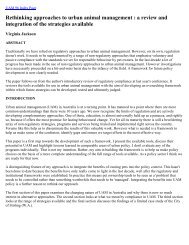Proceedings OF ThE - Australian Institute of Animal Management Inc
Proceedings OF ThE - Australian Institute of Animal Management Inc
Proceedings OF ThE - Australian Institute of Animal Management Inc
Create successful ePaper yourself
Turn your PDF publications into a flip-book with our unique Google optimized e-Paper software.
Annual Conference on <strong>Animal</strong> <strong>Management</strong> AIAM <strong>Proceedings</strong> 2012 85<br />
As can be seen in Table 1, the 80/20 rule applies<br />
to many diverse areas. Quite <strong>of</strong>ten though, it’s not<br />
always a strict 80/20 split, sometimes the ratio can<br />
be 90/10 or 95/5 etc. For example, in the field <strong>of</strong><br />
Criminology, depending on the area, about 4% <strong>of</strong> all<br />
victims experience 40% <strong>of</strong> the crimes. In another<br />
example, 6% <strong>of</strong> homes in a suburb location in the<br />
United States were responsible 60% <strong>of</strong> the calls for<br />
police service (Boba, 2005).<br />
Despite the departures from a strict 80/20 split in<br />
these observations, the 80/20 rule has some very<br />
real and practical implications. The 80/20 rule has<br />
been used for the following applications:<br />
• yImprove service delivery<br />
• y<strong>Inc</strong>rease productivity<br />
• y<strong>Inc</strong>rease pr<strong>of</strong>itability<br />
• y<strong>Inc</strong>rease efficiency<br />
• yIdentify target areas or individuals<br />
• yQuality control<br />
To illustrate, using the examples presented in<br />
Table 1, from a business perspective one may wish<br />
to enhance pr<strong>of</strong>its by providing special privileges to<br />
the 20% <strong>of</strong> customers that contribute to 80% <strong>of</strong> the<br />
pr<strong>of</strong>its. Some companies also use the 80/20 rule as<br />
a means <strong>of</strong> identifying top and low selling products<br />
and then either expand on their top 20% <strong>of</strong> products<br />
or discontinue their bottom selling products.<br />
Further to this, in the field <strong>of</strong> criminology, due to<br />
the observation that a large proportion <strong>of</strong> crimes<br />
committed are by repeat <strong>of</strong>fenders, intervention<br />
programs have been developed to prevent repeat<br />
<strong>of</strong>fending,<br />
Does the 80/20 rule apply to animal<br />
management?<br />
Given the applicability <strong>of</strong> the 80/20 rule to areas as<br />
diverse as the ones listed in Table 1 it is perhaps<br />
not surprising that examples <strong>of</strong> the principle can be<br />
observed in the area <strong>of</strong> animal management.<br />
Compliance/non-compliance: Notwithstanding<br />
variations within state and local municipality areas,<br />
the majority <strong>of</strong> people are compliant with animal<br />
management regulations while the minority are not.<br />
Based on the research in this area it appears that it<br />
is the minority who are responsible for many animal<br />
management compliance issues. To illustrate, Rohlf<br />
et al. (2010) found that 98% <strong>of</strong> dog owners report<br />
that their dog is confined to their property when<br />
required, 90.4% <strong>of</strong> dog <strong>of</strong> owners report that their<br />
dog is registered with their local council and 86%<br />
report that their dog is implanted with a microchip.<br />
Additional evidence <strong>of</strong> this uneven distribution<br />
can be found in Headey’s report (2006) on socially<br />
responsible pet ownership. Headey (2006) found that<br />
only 15% <strong>of</strong> the cat owners surveyed reported that<br />
their cat was rarely or never contained at night while<br />
91% <strong>of</strong> dog owners reported that they have their dog<br />
on leash when required to do so.<br />
Repeat <strong>of</strong>fenders: Anecdotal evidence also suggests<br />
the existence <strong>of</strong> repeat <strong>of</strong>fenders suggesting that<br />
a large proportion on the animal management<br />
issues are committed by repeat <strong>of</strong>fender. <strong>Animal</strong><br />
shelter and pounds <strong>of</strong>ten see dogs that have been<br />
impounded more than once and many animal<br />
management <strong>of</strong>ficers recount numerous situations<br />
where they are left to deal with an irresponsible dog<br />
or cat owners for failure to abide by a whole host <strong>of</strong><br />
animal management regulations.<br />
Hot spots: Similar to observations by those in the<br />
field <strong>of</strong> criminology anecdotal evidence suggests<br />
the presence <strong>of</strong> small areas that are the source <strong>of</strong><br />
numerous animal management issues. The City<br />
<strong>of</strong> Port Phillip’s Domestic <strong>Animal</strong> Plan 2008-11<br />
for instance observed that a high rise community<br />
housing facility was resident to an estimated 250<br />
animals however only 20 <strong>of</strong> these were registered<br />
with the council.<br />
Currently however, with the exception <strong>of</strong> a couple <strong>of</strong><br />
research papers, much <strong>of</strong> the evidence supporting<br />
the Pareto principle is anecdotal. Clearly then it is<br />
important that research be conducted in this area<br />
so that the ‘vital few’ that make the biggest impact<br />
to animal management are empirically identified. By<br />
identifying these areas efforts and resources can be<br />
appropriately directed to the most vital areas. In the<br />
meantime, 80/20 analyses can be easily and readily<br />
conducted on a local basis.<br />
How to conduct your own 80/20 analysis<br />
This kind <strong>of</strong> analysis can be an easy tool for the<br />
purpose <strong>of</strong> project management. Theoretically it<br />
allows you to tackle 80% <strong>of</strong> the problem by simply<br />
addressing 20% <strong>of</strong> the key causes.<br />
1. Determine the animal management problem(s)<br />
you wish to investigate and why<br />
For example, the problem may be the number<br />
<strong>of</strong> customer requests for animal management<br />
services. Investigating customer requests can be<br />
a time consuming and costly exercise. It might be<br />
worthwhile designing an intervention to reduce<br />
the number <strong>of</strong> these customer requests. However,<br />
if you’re like most councils it can be a daunting<br />
if not impossible task to investigate every issue<br />
especially if you want to see results within a year.<br />
The aim <strong>of</strong> this analysis will be to determine the<br />
vital few – the few critical issues that cause the<br />
majority <strong>of</strong> requests.



